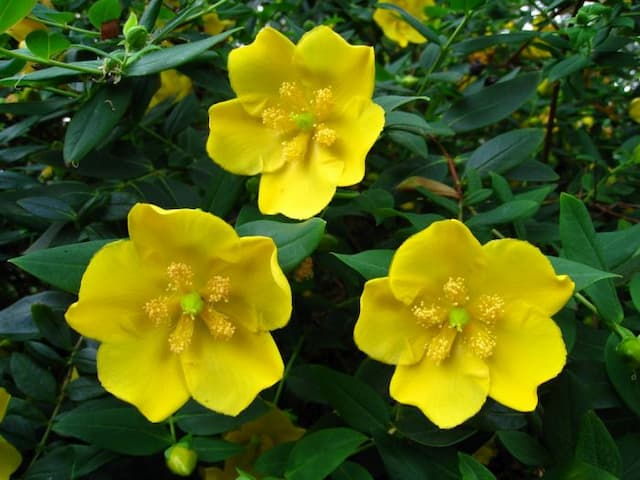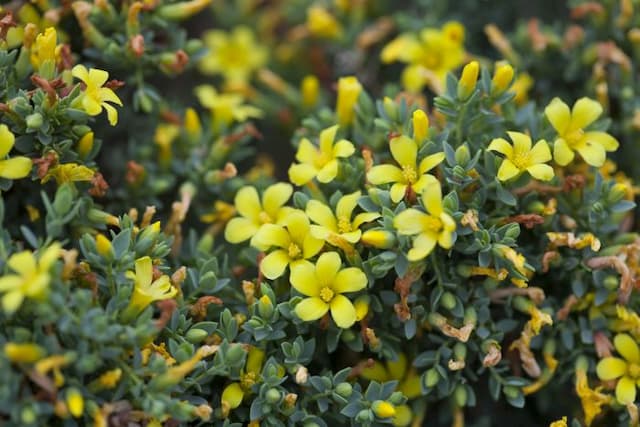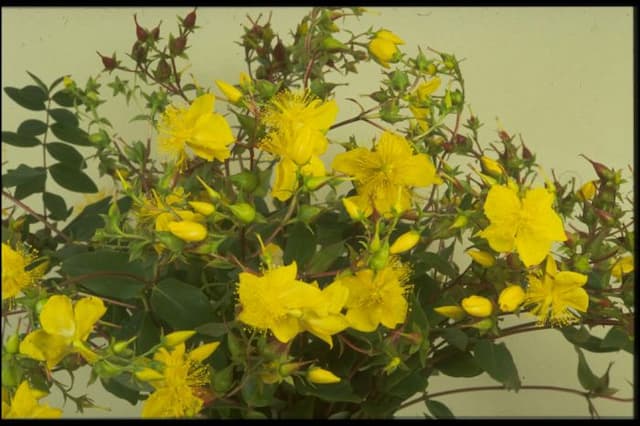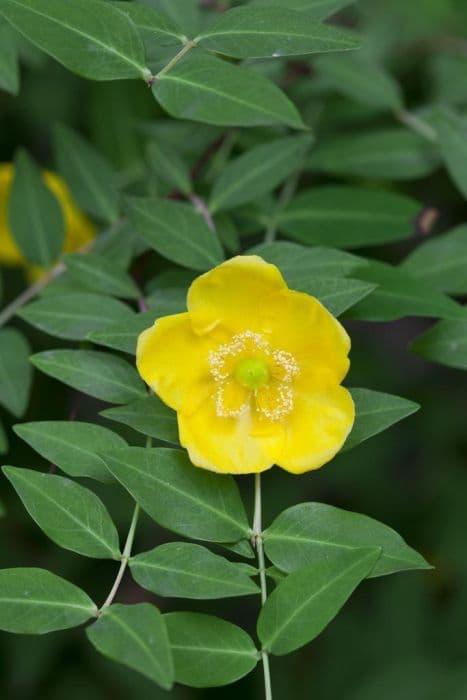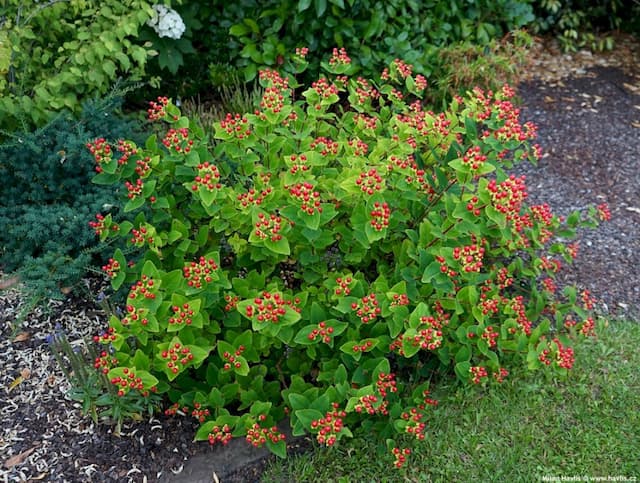St. John's Wort Hypericum × inodorum 'Elstead'

ABOUT
Hypericum × inodorum 'Elstead', commonly known as St. John's Wort, is a striking shrub that presents a dense, bushy appearance with an overall rounded habit. It is characterized by its smooth, dark green leaves that give a lush background to the profusion of flowers it displays. The leaves are simple with an elongated oval shape and have a slightly leathery texture, which adds to their glossy look. The plant is well-known for its beautiful flowers, which are a distinctive feature. The blooms are bright yellow with a multitude of stamen-like structures that emanate from the center, giving them a frilly or tufted appearance. These flowers are borne in clusters and can cover the shrub, offering a vibrant splash of color. After flowering, the plant produces ornamental berries that start off as a striking red and darken over time, possibly turning to a deep maroon or even black. The contrast between the foliage, yellow flowers, and the changing berries adds aesthetic appeal throughout different seasons. St. John's Wort has an upright form and the branches can be somewhat arching, giving it a graceful look. The overall aesthetic is one of a cheerful and robust plant, with a series of changing colors that make it a dynamic choice for ornamental gardens.
About this plant
 Names
NamesFamily
Hypericaceae.
Synonyms
St. John's Wort, Rose of Sharon.
Common names
Hypericum × inodorum 'Elstead'.
 Toxicity
ToxicityTo humans
Hypericum is generally considered to have low toxicity for humans. However, consuming parts of the plant, particularly in large amounts, can sometimes lead to adverse effects. If ingested, some people may experience gastrointestinal disturbances such as nausea, vomiting, or diarrhea. It may also cause restlessness and fatigue. Although severe poisoning is rare, it is recommended to consult a medical professional if ingestion occurs, especially in children, as their bodies are more sensitive to potential toxins.
To pets
Hypericum, commonly known as St. John’s Wort, can be toxic to pets, especially cats and dogs. If ingested, it may cause photosensitization, where skin becomes highly sensitive to sunlight, leading to skin irritation or ulceration upon sun exposure. Other symptoms include gastrointestinal upset, such as vomiting and diarrhea. In severe cases, it could lead to more serious complications, including damage to the nervous system. If you suspect your pet has ingested parts of the plant, you should seek veterinary assistance immediately.
 Characteristics
CharacteristicsLife cycle
Perennials
Foliage type
Deciduous
Color of leaves
Green
Flower color
Yellow
Height
3 feet (0.91 meters)
Spread
3 feet (0.91 meters)
Plant type
Shrub
Hardiness zones
5
Native area
Cultivar
Benefits
 General Benefits
General Benefits- Attractive Foliage: The shrub has appealing green leaves that can provide a lush backdrop in gardens.
- Yellow Flowers: Produces bright yellow flowers that add a splash of color to landscapes and attract pollinators.
- Drought Tolerance: Once established, it has good resistance to short periods of drought, making it suitable for xeriscaping.
- Low Maintenance: Requires minimal care once established, making it an easy choice for busy gardeners.
- Deer Resistance: Generally not preferred by deer, which can be beneficial in areas where deer predation is a problem.
- Seasonal Interest: Offers visual interest across seasons with flowers in summer and berry-like fruits in autumn.
- Border Planting: Works well in borders due to its moderate size and dense growth habit.
- Wildlife Attraction: The flowers and fruits attract birds and beneficial insects, promoting biodiversity.
 Medical Properties
Medical PropertiesThis plant is not used for medical purposes.
 Air-purifying Qualities
Air-purifying QualitiesThis plant is not specifically known for air purifying qualities.
 Other Uses
Other Uses- Photography: The bright yellow flowers of St. John's wort can be used in floral photography to create contrasting and vibrant images.
- Crafting: Dried stems and flowers of St. John's wort can be incorporated into wreaths and dried floral arrangements for decoration.
- Printing: The pigments from St. John's wort flowers can be used in natural plant-based printing techniques on fabric or paper.
- Dyeing: The flowers and leaves of St. John's wort can be used to produce a red or orange dye for textiles.
- Ink Production: The plant's extracts can be used to make natural inks for use in artistic endeavors or stamping.
- Natural Potpourri: Dried flowers and leaves can contribute to a natural potpourri blend with a subtle fragrance and attractive look.
- Landscape Design: St. John's wort is used as a decorative plant for its bushy habit and colorful berries, providing aesthetic appeal to gardens.
- Education: St. John's wort can serve as an educational tool for botany students, demonstrating plant structure and pollinator interactions.
- Erosion Control: Due to its dense growth, St. John's wort can be utilized for controlling erosion on slopes or in areas prone to soil degradation.
- Festive Decor: The bright berries and flowers can add festive color to holiday displays or as part of seasonal centerpieces.
Interesting Facts
 Feng Shui
Feng ShuiThe St. John's Wort is not used in Feng Shui practice.
 Zodiac Sign Compitability
Zodiac Sign CompitabilityThe St. John's Wort is not used in astrology practice.
 Plant Symbolism
Plant Symbolism- Protection: Hypericum, commonly known as St. John's Wort, is traditionally associated with safeguarding against negative influences and is believed to have protective qualities against evil spirits.
- Healing: The plant is well known for its healing properties, especially in herbal medicine where it's used to treat wounds and depression, symbolizing physical and emotional healing.
- Good Fortune: St. John's Wort is often thought to bring good luck and prosperity. Carrying a piece of the plant is believed to attract positive energy and fortune.
- Strength: With its resilience and vigorous growth, the plant symbolizes inner strength and the ability to overcome challenges.
- Happiness and Cheer: The bright yellow flowers of St. John's Wort represent joy and cheerfulness, providing a burst of positivity to anyone who encounters it.
 Water
WaterSt. John's Wort should be watered deeply and thoroughly, allowing the soil to slightly dry out between waterings. The frequency of watering largely depends on weather conditions and soil type, but on average, during the growing season, it might need water every one to two weeks. When irrigating, aim to provide about 1 gallon of water per square foot of soil. During hot, dry spells, the plant may require more frequent watering to keep the soil consistently moist. However, in cooler weather or if the plant is established and there is rainfall, you may need to water less often.
 Light
LightSt. John's Wort thrives in full sun to partial shade. The ideal location is where the plant can receive at least 6 hours of direct sunlight daily, but it will also perform well in locations with some afternoon shade. Avoid deep shade as it will compromise the density of foliage and abundance of flowers.
 Temperature
TemperatureSt. John's Wort prefers moderate climates and is hardy in a range of temperatures. It can tolerate a minimum temperature down to about 0 degrees Fahrenheit, while the maximum temperature for healthy growth shouldn't exceed 95 degrees Fahrenheit. Ideal growing conditions are found with temperatures consistently between 60 and 70 degrees Fahrenheit.
 Pruning
PruningSt. John's Wort can be pruned to shape the plant, remove dead wood, and encourage bushier growth. Prune early in the spring before new growth appears, cutting back about a third of the old branches to stimulate fresh growth. Deadheading spent flowers throughout the growing season can also promote additional blooming.
 Cleaning
CleaningAs needed
 Soil
SoilSt. John's Wort 'Elstead' prefers well-draining soil with a pH ranging from slightly acidic to neutral. The best soil mix consists of garden soil, compost, and sharp sand or perlite to ensure good drainage. Adjust the pH if necessary with sulfur to lower it or lime to increase it.
 Repotting
RepottingSt. John's Wort 'Elstead' should be repotted every 2 to 3 years or when it outgrows its current pot. Use the same soil mix as recommended, and choose a pot that is one size larger than the previous one.
 Humidity & Misting
Humidity & MistingSt. John's Wort 'Elstead' tolerates a wide range of humidity levels but thrives best in average room humidity. Protect it from excessively dry air by avoiding placement near heating vents in winter.
 Suitable locations
Suitable locationsIndoor
Place St. John's Wort 'Elstead' in bright, indirect light indoors.
Outdoor
Plant St. John's Wort 'Elstead' in partial to full sun outside.
Hardiness zone
5-9 USDA
 Life cycle
Life cycleHypericum × inodorum 'Elstead', commonly known as St John's Wort 'Elstead', begins its life cycle as a seed, which requires well-drained soil and adequate sunlight to germinate and develop into a seedling. As the seedling matures, it forms a robust root system and foliage during its vegetative growth phase. Flower buds emerge and bloom in the summer, displaying clusters of yellow flowers that attract pollinators and facilitate cross-pollination. Following pollination, the plant produces small, berry-like fruits (which are typically not a primary feature for this ornamental variety) that contain seeds, completing its reproductive stage. With the onset of colder weather, Hypericum 'Elstead' may die back to the ground in colder climates but will remain evergreen or semi-evergreen in milder regions. The plant can live several years, with pruning in early spring to encourage bushier growth and more prolific blooming in the subsequent season.
 Propogation
PropogationPropogation time
Spring-Early Summer
Hypericum × inodorum 'Elstead', commonly known as St. John's Wort, is typically propagated through softwood cuttings. The best time to take these cuttings is in late spring or early summer when the plant's new growth is beginning to mature and is still somewhat pliable. To propagate, a gardener would take a 4 to 6 inch (about 10 to 15 cm) stem cutting just below a leaf node, remove the lower leaves, and dip the cut end into a rooting hormone powder or solution. The prepared cutting is then planted in a well-draining soil mixture, ensuring that the leaf nodes where the lower leaves were removed are buried, as roots will develop from these points. The cutting should be kept moist until roots have developed and it can be transplanted into the garden or a larger container. This method is favored for its simplicity and effectiveness in producing clones of the parent plant.
